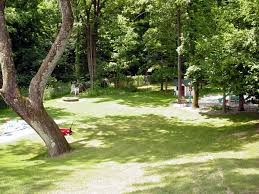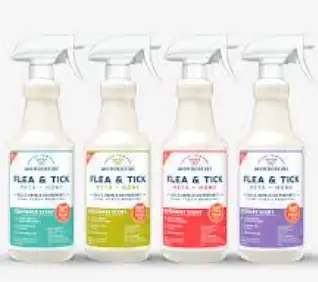Last Updated on 05/01/2025 by Kimberly
Fleas are a nightmare for pet owners and homeowners alike. These tiny pests can cause a lot of discomfort for both animals and humans. Getting on top of flea control is crucial to keep your home and pets healthy. Learn the best flea control home solutions you can use to kill fleas. The key to success lies in understanding the life cycle of fleas and acting promptly.
Fleas go through four distinct stages: egg, larva, pupa, and adult. Each stage needs a different approach to effectively tackle the infestation. This means using a combination of treatments and actions to make sure you’re hitting fleas at every life stage. If this isn’t done right, fleas can keep coming back, causing a recurring problem.
Effective flea control isn’t just about getting rid of the fleas you can see. It’s about breaking the lifecycle and ensuring your home stays flea-free. Fleas can carry diseases and cause allergic reactions, which can be harmful to both pets and humans. Therefore, taking flea control seriously isn’t just about comfort, it’s also about health and well-being.
To be effective in your flea control efforts, it’s crucial to understand not only the life cycle of fleas but also their potential impact. Fleas can cause intense itching and discomfort for pets, leading to potential skin infections.
For humans, flea bites can result in itchy welts and allergic reactions. In rare cases, fleas can transmit diseases, making them much more than just a pesky nuisance.
Getting started with a solid plan for flea control is essential. This means treating your pets, addressing both indoor and outdoor areas, and maintaining a clean home. Throughout this guide, I’ll walk you through each step to make sure you’re armed with all the information you need for effective flea control.
Step 1: Best Flea Control Home Solution: Treat Your Pets for Fleas
First things first, getting your pets treated is the cornerstone of effective flea control. Fleas love to make their home in your pet’s fur, and if you don’t address the issue at this source, you’re fighting an uphill battle.
There are several options for treating pets for fleas. Topical treatments, oral medications, and flea collars are the most common and effective choices. Each type has its own advantages, so choosing the right one depends on your pet’s needs and lifestyle.
Topical treatments, like spot-on solutions, are applied directly to your pet’s skin and offer long-lasting protection. They’re easy to use and can kill fleas within hours. Oral medications are pills or chewable tablets that your pet eats. These work from the inside out, often killing fleas before they lay eggs. Flea collars are another option, providing extended control over several months.
It’s crucial to consult your veterinarian to find the best flea treatment for your pet. Your vet can recommend specific brands or types that are most effective and safe for your pet. Also, always follow the instructions on the product label to ensure proper application and effectiveness.
Consistency is key. Once you’ve chosen a treatment, make sure to apply it regularly as recommended. This will help prevent any new infestations and keep fleas from coming back. Remember, treating your pets should be the first step in your comprehensive flea control strategy.
Step 2: Best Flea Control Home Solution: Outdoor Flea Control
Controlling fleas isn’t limited to just inside your home. Taking care of your yard is equally important. Fleas often thrive in outdoor environments and can easily hitch a ride inside on your pets or even on your clothing.
Start by identifying flea hotspots in your yard. Shaded areas, patches with higher humidity, and places where your pets love to hang out are usually prime spots. Keeping your lawn well-maintained can go a long way. Regularly mowing the grass, trimming bushes, and raking leaves removes the cool, damp environments where fleas love to breed.
Consider using outdoor flea control products. There are sprays and granules specifically designed to be applied to lawns and garden areas. Often, these products contain insect growth regulators (IGRs) that help halt the flea life cycle. Make sure to follow the instructions on the product labels for safe and effective application.
Most Recommended
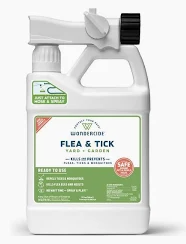
Wondercide Flea & Tick Yard Spray
$37.99
Made With Essential Oils
Top Seller
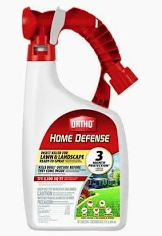
Ortho Home Defense Yard Spray
$17.79
Made With Insectcides
Best Price
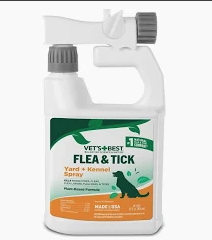
Vet’s Best Flea & Tick Yard Spray
$16.97
Made With Certified Natural Oils
For a natural approach, diatomaceous earth is a great option. This fine powder is harmless to pets and humans but deadly to fleas. It works by dehydrating the fleas on contact. Sprinkle it in suspected flea-prone areas, but remember to reapply after it rains as water can render it ineffective.
Don’t forget areas where your pets like to rest outside, such as dog houses, kennels, or under shaded trees. Keeping these spots clean and treating them with appropriate flea control measures ensures they don’t become hotspot nurseries for fleas.
Addressing outdoor areas is a significant step in your overall flea control plan. By minimizing the flea population outside, you’re reducing the risk of them making their way into your home again.
Step 3: Best Flea Control Home Solution: Indoor Cleaning and Flea Control
Once your pets are taken care of and your yard is addressed, it’s time to focus on the inside of your home. Fleas can hide almost anywhere, making thorough cleaning essential.
Start with the basics: wash all your bedding, pet bedding, and any linens that can fit in the washer. Use hot water and the highest dryer setting to kill any fleas, eggs, or larvae that might be lurking. This step removes a significant portion of the infestation from soft materials.
Next, grab your vacuum and get ready to cover every inch of your home. Fleas love to hide in carpets, rugs, and upholstery, so these areas need special attention. Make sure to vacuum under furniture, between cushions, and along baseboards. Don’t forget hard-to-reach places where fleas might be lurking. After vacuuming, empty the vacuum bag or canister into a sealed trash bag and dispose of it outside your home to prevent any fleas from escaping.
For hard surfaces, mopping with hot water and soap can help remove any fleas or eggs. Pay special attention to corners and crevices where fleas might be hiding. Using a mop with disposable pads can be especially handy for ensuring you’re not spreading fleas around.
Using a flea spray can add an extra layer of protection. Flea sprays designed for home use can target both adult fleas and developing stages. Apply the spray to carpets, furniture, and even along the baseboards. Follow the product instructions carefully for maximum effectiveness and safety.
The key to indoor flea control is thoroughness. Fleas have a knack for hiding in the smallest nooks and crannies, so make your cleaning as comprehensive as possible. By tackling all these indoor areas methodically, you’re well on your way to breaking the flea lifecycle inside your home.
Step 4: Best Flea Control Home Solutions: Effective Flea Sprays
Selecting the right flea spray can be a game changer in your battle against fleas. Not all sprays are created equal, and finding one that fits your needs can significantly impact how effective your flea control efforts are.
First, understand the types of flea sprays available. There are contact sprays, which kill fleas on contact, and residual sprays, which continue to work for several weeks after application. Some products also include insect growth regulators (IGRs) that prevent flea eggs and larvae from developing into adults, breaking the lifecycle right there.
Safety is paramount, especially if you have pets or children. Read product labels to ensure the spray is safe for indoor use and won’t harm your furry friends. Some flea sprays are made from natural ingredients, offering a safer alternative, although they may need more frequent application.
Application techniques matter. For broad coverage, spray evenly over carpets, upholstery, and baseboards. Pay extra attention to areas where your pets frequent, as these are likely flea hotspots. Always follow the manufacturer’s instructions for both application and drying times to ensure the spray is effective.
Storage and handling are also crucial for maintaining the spray’s efficacy. Keep flea sprays in a cool, dry place and away from direct sunlight. Proper storage ensures the active ingredients remain potent.
Top recommended sprays, considering effectiveness and safety, include products like Cedarcide Flea & Tick Spray and Wondercide Flea and Tick Home Spray. These have a good track record for targeting multiple stages of the flea life cycle, making them reliable choices for home use.
Top Selling Item
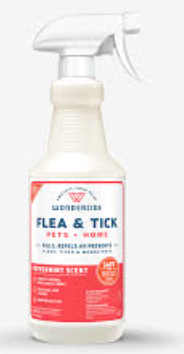
Wondercide Flea & Tick Control For Pets & Home
$26.99
Made With Essential Oils
Top Rated
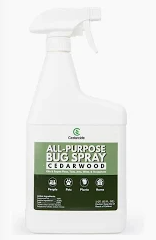
Cedarcide Flea – Tick & Bug Spray For Pets & Home
$33.94
Made With Natural Cedar Oil
Best Price
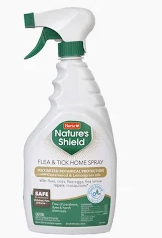
Hartz Natural Shield Flea & Tick Spray For Home
$9.98
Made With Essential Oils
Incorporating a high-quality flea spray into your overall flea control strategy can make a noticeable difference. By choosing the right product and using it correctly, you’re adding a powerful tool to your flea-fighting arsenal.
Maintaining a Flea-Free Environment
After you’ve managed to get flea control under wraps, the next step is maintaining this flea-free environment. Regular monitoring and preventive measures are crucial to ensure the fleas don’t make a comeback.
Stay vigilant for signs of fleas. Check your pets regularly by combing through their fur with a flea comb. Look out for flea dirt (tiny black specks) and adult fleas. Early detection can help you tackle the issue before it becomes a full-blown infestation again.
Household cleanliness remains a priority. Continue vacuuming regularly, especially in areas where your pets spend a lot of time. This not only helps in catching any stray fleas but also removes eggs that might have been laid. Regular washing of pet bedding, your linens, and soft furnishings in hot water is equally important.
Consider using flea preventatives on your pets consistently. Monthly topical treatments or flea collars can keep your pets protected from re-infestation. Consult your vet for recommendations tailored to your pet’s health and lifestyle.
Outdoor maintenance also plays a part. Regularly treat your yard and maintain a tidy, well-mowed lawn. Remove any piles of leaves or organic debris where fleas could thrive. Diatomaceous earth can be a useful, natural tool in keeping your yard flea-free.
Creating a flea-free zone for your pets can also be effective. Designate a specific sleeping area with a pet bed that’s easy to clean. Keeping your pets out of certain high-risk areas, like basements or garages, can also minimize their exposure to fleas.
By staying proactive and maintaining these practices, you can protect your home from future flea infestations. Remember, consistency and vigilance are your best allies in keeping your environment flea-free.
In Conclusion To What The Best Flea Control Home Products Are
I hope you were able to find all the answers that you need to make your home completely flea free. It may seem like a lot right now but the initial steps are well worth the simple preventative steps you need to follow later on.
If you have tried any of the above steps or anything else that has worked for you, please share it in the comments section. If you have any questions about any of the information in this article, please leave a comment below so we can help you.
Thank you for visiting Fleas B Gone, have a great day 🙂



